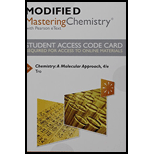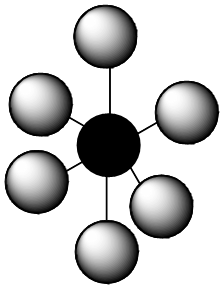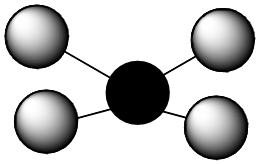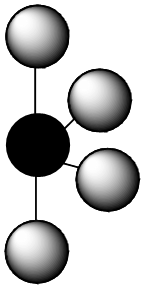
Modified Mastering Chemistry with Pearson eText -- Standalone Access Card -- for Chemistry: A Molecular Approach (4th Edition)
4th Edition
ISBN: 9780134162430
Author: Nivaldo J. Tro
Publisher: PEARSON
expand_more
expand_more
format_list_bulleted
Concept explainers
Question
Chapter 10, Problem 34E
Interpretation Introduction
Interpretation: The number of total electron groups, the number of bonding groups and the number of lone pairs on the central atom.

(b)

(c)

Concept Introduction:
Molecular geometry is the 3-dimensional shape that amolecule occupies in space. It is determined by the central atom and the surrounding atoms and electron pairs.
Expert Solution & Answer
Want to see the full answer?
Check out a sample textbook solution
Students have asked these similar questions
presented by Morillon Leaning
Predict the organic product for the min
кусур
HSC
Adithane carved arnown to come than that to the condon
slchroruis in acid in in aquishri with
ною
6.15PM
Sun Mar 30
K
Draw the major product of this reaction. Include
any relevant stereochemistry. Ignore inorganic
byproducts.
Problem 1 of
O
H
[PhзPCH2CH3]*C|¯
NaH
Drawing
>
Q
Atoms,
Bonds and
Draw or tap a ne
8:17 PM Sun Mar 30
Draw the major product of this reaction. Ignore
inorganic byproducts.
HSCH2CH2CH2SH, BF3
Probler
Drawing
Ato
Bonds
Cl
Chapter 10 Solutions
Modified Mastering Chemistry with Pearson eText -- Standalone Access Card -- for Chemistry: A Molecular Approach (4th Edition)
Ch. 10 - Prob. 1SAQCh. 10 - Prob. 2SAQCh. 10 - Prob. 3SAQCh. 10 - Prob. 4SAQCh. 10 - Prob. 5SAQCh. 10 - Prob. 6SAQCh. 10 - Prob. 7SAQCh. 10 - Prob. 8SAQCh. 10 - Prob. 9SAQCh. 10 - Q10. Apply molecular orbital theory to predict...
Ch. 10 - Q11. Apply molecular orbital theory to determine...Ch. 10 - Q12. Which hybridization scheme occurs about...Ch. 10 - Q13. Which molecular geometry results when a...Ch. 10 - Prob. 14SAQCh. 10 - Prob. 15SAQCh. 10 - 1. Why is molecular geometry important? Cite some...Ch. 10 - 2. According to VSEPR theory, what determines the...Ch. 10 - 3. Name and sketch the five basic electron...Ch. 10 - 4. Explain the difference between electron...Ch. 10 - 5. Give the correct electron and molecular...Ch. 10 - 6. How do you apply VSEPR theory to predict the...Ch. 10 - Prob. 7ECh. 10 - Prob. 8ECh. 10 - 9. In valence bond theory, what determines the...Ch. 10 - 10. In valence bond theory, the interaction energy...Ch. 10 - Prob. 11ECh. 10 - Prob. 12ECh. 10 - 13. How is the number of hybrid orbitals related...Ch. 10 - Prob. 14ECh. 10 - Prob. 15ECh. 10 - 16. Name the hybridization scheme that corresponds...Ch. 10 - Prob. 17ECh. 10 - Prob. 18ECh. 10 - 19. What is a bonding molecular orbital?
Ch. 10 - 20. What is an antibonding molecular orbital?
Ch. 10 - 21. What is the role of wave interference in...Ch. 10 - Prob. 22ECh. 10 - 23. How is the number of molecular orbitals...Ch. 10 - 24. Sketch each molecular orbital.
a. σ2s
b.
c....Ch. 10 - Prob. 25ECh. 10 - Prob. 26ECh. 10 - Prob. 27ECh. 10 - Prob. 28ECh. 10 - Prob. 29ECh. 10 - 30. Write a short paragraph describing chemical...Ch. 10 - 31. A molecule with the formula AB3 has a trigonal...Ch. 10 - 32. A molecule with the formula AB3 has a trigonal...Ch. 10 - 33. For each molecular geometry, list the number...Ch. 10 - Prob. 34ECh. 10 - 35. Determine the electron geometry, molecular...Ch. 10 - 36. Determine the electron geometry, molecular...Ch. 10 - 37. Which species has the smaller bond angle, H3O...Ch. 10 - Prob. 38ECh. 10 - 39. Determine the molecular geometry and sketch...Ch. 10 - Prob. 40ECh. 10 - Prob. 41ECh. 10 - Prob. 42ECh. 10 - 43. Each ball-and-stick model shows the electron...Ch. 10 - 44. Each ball-and-stick model shows the electron...Ch. 10 - 45. Determine the geometry about each interior...Ch. 10 - Prob. 46ECh. 10 - Prob. 47ECh. 10 - Prob. 48ECh. 10 - Prob. 49ECh. 10 - Prob. 50ECh. 10 - 51. Determine whether each molecule is polar or...Ch. 10 - Prob. 52ECh. 10 - 53. The valence electron configurations of several...Ch. 10 - 54. The valence electron configurations of several...Ch. 10 - 55. Write orbital diagrams (boxes with arrows in...Ch. 10 - Prob. 56ECh. 10 - 57. Write orbital diagrams (boxes with arrows in...Ch. 10 - Prob. 58ECh. 10 - 59. Which hybridization scheme allows the...Ch. 10 - Prob. 60ECh. 10 - Prob. 61ECh. 10 - 62. Write a hybridization and bonding scheme for...Ch. 10 - Prob. 63ECh. 10 - 64. Write a hybridization and bonding scheme for...Ch. 10 - 65. Write a hybridization and bonding scheme for...Ch. 10 - Prob. 66ECh. 10 - 67. Consider the structure of the amino acid...Ch. 10 - 68. Consider the structure of the amino acid...Ch. 10 - 69. Sketch the bonding molecular orbital that...Ch. 10 - Prob. 70ECh. 10 - 71. Draw an MO energy diagram and predict the bond...Ch. 10 - Prob. 72ECh. 10 - Prob. 73ECh. 10 - Prob. 74ECh. 10 - Prob. 75ECh. 10 - 76. Using the molecular orbital energy ordering...Ch. 10 - 77. Use molecular orbital theory to predict if...Ch. 10 - 78. Use molecular orbital theory to predict if...Ch. 10 - Prob. 79ECh. 10 - Prob. 80ECh. 10 - 81. Draw an MO energy diagram for CO. (Use the...Ch. 10 - Prob. 82ECh. 10 - 83. For each compound, draw the Lewis structure,...Ch. 10 - 84. For each compound, draw the Lewis structure,...Ch. 10 - 85. Amino acids are biological compounds that link...Ch. 10 - 86. The genetic code is based on four different...Ch. 10 - 87. The structure of caffeine, present in coffee...Ch. 10 - 88. The structure of acetylsalicylic acid...Ch. 10 - 89. Most vitamins can be classified as either fat...Ch. 10 - 90. Water does not easily remove grease from...Ch. 10 - Prob. 91ECh. 10 - Prob. 92ECh. 10 - 93. Bromine can form compounds or ions with any...Ch. 10 - 94. The compound C3H4 has two double bonds....Ch. 10 - Prob. 95ECh. 10 - Prob. 96ECh. 10 - Prob. 97ECh. 10 - 98. Indicate which orbitals overlap to form the s...Ch. 10 - 99. In VSEPR theory, which uses the Lewis model to...Ch. 10 - 100. The results of a molecular orbital...Ch. 10 - 101. The results of a molecular orbital...Ch. 10 - Prob. 102ECh. 10 - Prob. 103ECh. 10 - Prob. 104ECh. 10 - Prob. 105ECh. 10 - 106. Neither the VSEPR model nor the hybridization...Ch. 10 - 107. Draw the Lewis structure for acetamide...Ch. 10 - Prob. 108ECh. 10 - 109. Which statement best captures the fundamental...Ch. 10 - 110. Suppose that a molecule has four bonding...Ch. 10 - 111. How does each of the three major bonding...Ch. 10 - Prob. 112ECh. 10 - Prob. 113QGWCh. 10 - Prob. 114QGWCh. 10 - Prob. 115QGWCh. 10 - Prob. 116QGWCh. 10 - Prob. 117QGWCh. 10 - Prob. 118DIA
Knowledge Booster
Learn more about
Need a deep-dive on the concept behind this application? Look no further. Learn more about this topic, chemistry and related others by exploring similar questions and additional content below.Similar questions
- Name the major organic product of the following action of 4-chloro-4-methyl-1-pentanol in neutral pollution 10+ Now the product. The product has a molecular formula f b. In a singly hain, the starting, material again converts into a secule with the molecular kormula CIO. but with comply Draw the major organic structure inhalationarrow_forwardMacmillan Learning Alcohols can be oxidized by chromic acid derivatives. One such reagent is pyridinium chlorochromate, (C,H,NH*)(CICTO3), commonly known as PCC. Draw the proposed (neutral) intermediate and the organic product in the oxidation of 1-butanol by PCC when carried out in an anhydrous solvent such as CH₂C₁₂. PCC Intermediate OH CH2Cl2 Draw the intermediate. Select Draw Templates More с H Cr о Product Draw the product. Erase Select Draw Templates More H о Erasearrow_forwardIf I have 1-bromopropene, to obtain compound A, I have to add NaOH and another compound. Indicate which compound that would be. A C6H5 CH3arrow_forward
- Provide the reagents for the following reactions.arrow_forwardIf I have 1-bromopropene, to obtain compound Z, I have to add two compounds A1 and A2. Indicate which compounds are needed. P(C6H5)3arrow_forwardDraw the major product of this reaction. Ignore inorganic byproducts. Assume that the water side product is continuously removed to drive the reaction toward products. O CH3CH2NH2, TSOH Select to Draw >arrow_forward
arrow_back_ios
SEE MORE QUESTIONS
arrow_forward_ios
Recommended textbooks for you
 ChemistryChemistryISBN:9781305957404Author:Steven S. Zumdahl, Susan A. Zumdahl, Donald J. DeCostePublisher:Cengage Learning
ChemistryChemistryISBN:9781305957404Author:Steven S. Zumdahl, Susan A. Zumdahl, Donald J. DeCostePublisher:Cengage Learning ChemistryChemistryISBN:9781259911156Author:Raymond Chang Dr., Jason Overby ProfessorPublisher:McGraw-Hill Education
ChemistryChemistryISBN:9781259911156Author:Raymond Chang Dr., Jason Overby ProfessorPublisher:McGraw-Hill Education Principles of Instrumental AnalysisChemistryISBN:9781305577213Author:Douglas A. Skoog, F. James Holler, Stanley R. CrouchPublisher:Cengage Learning
Principles of Instrumental AnalysisChemistryISBN:9781305577213Author:Douglas A. Skoog, F. James Holler, Stanley R. CrouchPublisher:Cengage Learning Organic ChemistryChemistryISBN:9780078021558Author:Janice Gorzynski Smith Dr.Publisher:McGraw-Hill Education
Organic ChemistryChemistryISBN:9780078021558Author:Janice Gorzynski Smith Dr.Publisher:McGraw-Hill Education Chemistry: Principles and ReactionsChemistryISBN:9781305079373Author:William L. Masterton, Cecile N. HurleyPublisher:Cengage Learning
Chemistry: Principles and ReactionsChemistryISBN:9781305079373Author:William L. Masterton, Cecile N. HurleyPublisher:Cengage Learning Elementary Principles of Chemical Processes, Bind...ChemistryISBN:9781118431221Author:Richard M. Felder, Ronald W. Rousseau, Lisa G. BullardPublisher:WILEY
Elementary Principles of Chemical Processes, Bind...ChemistryISBN:9781118431221Author:Richard M. Felder, Ronald W. Rousseau, Lisa G. BullardPublisher:WILEY

Chemistry
Chemistry
ISBN:9781305957404
Author:Steven S. Zumdahl, Susan A. Zumdahl, Donald J. DeCoste
Publisher:Cengage Learning

Chemistry
Chemistry
ISBN:9781259911156
Author:Raymond Chang Dr., Jason Overby Professor
Publisher:McGraw-Hill Education

Principles of Instrumental Analysis
Chemistry
ISBN:9781305577213
Author:Douglas A. Skoog, F. James Holler, Stanley R. Crouch
Publisher:Cengage Learning

Organic Chemistry
Chemistry
ISBN:9780078021558
Author:Janice Gorzynski Smith Dr.
Publisher:McGraw-Hill Education

Chemistry: Principles and Reactions
Chemistry
ISBN:9781305079373
Author:William L. Masterton, Cecile N. Hurley
Publisher:Cengage Learning

Elementary Principles of Chemical Processes, Bind...
Chemistry
ISBN:9781118431221
Author:Richard M. Felder, Ronald W. Rousseau, Lisa G. Bullard
Publisher:WILEY
Stoichiometry - Chemistry for Massive Creatures: Crash Course Chemistry #6; Author: Crash Course;https://www.youtube.com/watch?v=UL1jmJaUkaQ;License: Standard YouTube License, CC-BY
Bonding (Ionic, Covalent & Metallic) - GCSE Chemistry; Author: Science Shorts;https://www.youtube.com/watch?v=p9MA6Od-zBA;License: Standard YouTube License, CC-BY
General Chemistry 1A. Lecture 12. Two Theories of Bonding.; Author: UCI Open;https://www.youtube.com/watch?v=dLTlL9Z1bh0;License: CC-BY